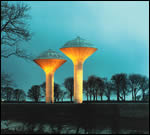|




|
 Water
is one of the prime natural resources, an essential commodity for all living
systems, but vulnerable to contamination and pollution by human activities.
It is continually renewed by the natural hydrological cycle of evaporation,
vapour transportation and rainfall. In many semiarid areas of the world
water has to be collected each day, often by women and children, walking
many miles to the nearest well, yet in the developed world we expect to
be able to turn on the tap and have as much water as we want, when we want.
Not only that, but we expect it all to be clean and safe to drink, even
though only a small fraction will be actually consumed or used for food
preparation. Water
is one of the prime natural resources, an essential commodity for all living
systems, but vulnerable to contamination and pollution by human activities.
It is continually renewed by the natural hydrological cycle of evaporation,
vapour transportation and rainfall. In many semiarid areas of the world
water has to be collected each day, often by women and children, walking
many miles to the nearest well, yet in the developed world we expect to
be able to turn on the tap and have as much water as we want, when we want.
Not only that, but we expect it all to be clean and safe to drink, even
though only a small fraction will be actually consumed or used for food
preparation.
|
|

In third world countries
the lack of water has contributed to the death of 100 million children in
the past 20 years. Many millions more people have died from waterborne diseases
such as cholera, typhoid, and dysentery contracted from inadequate and polluted
drinking water sources. Water supply is a primary infrastructural need of
all communities worldwide, playing a key role in the promotion of public
health and the elimination of disease. While there are many problem areas
in the world today, the overall quality of public water supplies in the
Republic of Ireland are amongst the highest in Europe.

Every day each one of us uses large quantities of water. It is vital for
drinking and cooking, and for many other domestic and agricultural uses.
Industry uses water
in vast quantities to manufacture everything from paper to motor cars,
electricity to computers. High quality water is used, for example, in
the electric power generation, pharmaceutical and semi-conductor industries.
A supply of water is also required to protect our homes, our workplaces
and our livelihoods from the dangers of fire.
During the last century
engineers have developed the technologies used to control and modulate
water quality to meet the European
Union standards that govern its use for drinking purposes and its related
uses in industrial manufacturing. The treatment and distribution of clean
drinking water requires an enormous investment both in money and expertise
and a considerable commitment from local authorities and others whose
job it is to supply our water.

In the West of Ireland,
this investment and commitment has been remarkable since the 1960¹s
and has coincided with the surge in our economic development in the intervening
period. Prior to that time only the larger towns in the region had any
degree of water treatment, storage facilities and distribution network.
Most rural areas had only individual water supply systems deriving water
primarily from groundwater sources.
|
|
 
 In
the 1960's and 1970's the Government invested in the development of group
schemes to supply landowners and householders in rural areas. In parallel
the local authorities embarked on: In
the 1960's and 1970's the Government invested in the development of group
schemes to supply landowners and householders in rural areas. In parallel
the local authorities embarked on:
- the identification
of sources capable of supplying larger regions of each county
- the planning and
construction of regional schemes involving water treatment plants, water
storage facilities and distribution pipe networks to supply the needs
of these regions.
To these ends, the
counties of Mayo and Galway in particular are blessed with a large number
of inland lakes with excellent water quality such as L Corrib in North
Galway, L. Mask in South Mayo, L. Conn and L. Carrowmore in North Mayo,
Corrymore Lake in Achill, and Lough Rea in east Galway.
These lakes have been identified and used by the local authorities as
sources for large regional water supply schemes to supply most of counties
of Mayo and Galway. Public water supplies in County Roscommon are mainly
derived from groundwater sources.
The hundreds of millions
of pounds necessary to provide the existing and continuing development
of water supply infrastructure in the region through the implementation
of these schemes over the last 25 years have been made possible by grant
aid from EU Structural and Cohesion funds.
|

